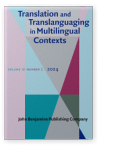Vol. 10:2 (2024) ► pp.166–187
Vol. 10:2 (2024) ► pp.166–187
“It’s normal. That’s just my life”
Tatar-Russian bilinguals’ translanguaging and tranßcripting in multiple linguascapes
This study explores Tatar-Russian bilinguals’ dynamic translanguaging and tranßcripting practices in Tatar, Russian, English, and Arabic. Based on interviews with six Tatar-Russian bilinguals as well as their written social media postings and audio recordings of voice messages over six months, the study illustrates the participants’ linguistic practices and their perceptions of bilingualism and relevant practices. The results demonstrate that the bilinguals engaged in various forms of translanguaging practices and regarded them as their everyday practices, emphasizing their ordinariness for bilingual interaction. The results also show that they expanded and reinvented their translanguaging into creative and playful tranßcripting practices in social media, regardless of their divergent attitudes towards each of the languages. The bilinguals projected their identity as cool multilingual youth through the tranßcripting practices that cross the linguistic boundaries between Russian (dominant state language), Tatar (dominant local), Arabic (religious), and English (peripheral global). By examining complex and dynamic relationships between multiple languages in an underrepresented region, this study highlights how translanguaging and tranßcripting practices reflect multilinguals’ everyday practices and their dynamic identity that go beyond the boundaries of the local languages and cultures.
Article outline
- 1.Introduction
- 2.Literature review
- 2.1Translanguaging, tranßcripting, and linguascape
- 2.2History of Tatar and Russian bilingualism and translanguaging practices
- 3.Methodology
- 3.1Participants
- 3.2Data collection
- 3.3Data analysis
- 4.Results and discussion
- 4.1Translanguaging as bilingual identity: “It is normal. That’s just my life”
- 4.2Translanguaging in everyday communication
- 4.3Tranßcripting in online communication
- 4.4Translanguaging and tranßcripting as multilingual youth’s emergent identity
- 5.Conclusion and implications
-
References
